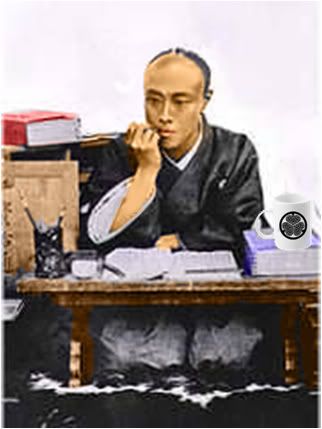 While Pepsi Shiso may be a liquid car wreck in a bottle, Tokugawa Shogun Coffee, sold by Saza Coffee, is nothing short of heaven in a mug. Now some of you are probably scratching your heads wondering what the heck “Shogun Coffee” is. Is this some sort of gimmick meant to cash in on the “history” boom that is sweeping across Japan? No, it isn’t and this is all about really good coffee with a pedigreed history!
While Pepsi Shiso may be a liquid car wreck in a bottle, Tokugawa Shogun Coffee, sold by Saza Coffee, is nothing short of heaven in a mug. Now some of you are probably scratching your heads wondering what the heck “Shogun Coffee” is. Is this some sort of gimmick meant to cash in on the “history” boom that is sweeping across Japan? No, it isn’t and this is all about really good coffee with a pedigreed history!The story starts in 1867, as the turmoil of the Bakumatsu period was reaching fever pitch. The 15th and last Tokugawa Shogun, Yoshinobu, was desperately trying to modernize the Bakufu’s finances and military capabilities. For this, he turned to the French, who at the time were led by Emperor Napoleon III, who dreamed of expanding France’s sphere of influence in Asia. Nothing against France, but perhaps the Shogunate’s decision to rely on France wasn’t the wisest choice, as things didn’t really work out that well for both parties’ positions in Japan. However, you can’t blame the Tokugawa for looking to France over Britain when it came to the culinary arts. Besides pork, there was another item in France’s culinary arsenal that captivated Yoshinobu, and that was coffee. Although the Saza coffee site says coffee was officially introduced to Japan in 1867, I have a hunch it probably wasn’t something extraordinary new to the Japanese ruling elite, as the Dutch were exporting it by the ton from their holdings in Indonesia and had probably been presented to the court of the Shogun via the Dutch settlement in Nagasaki. Perhaps even Perry served some to visitors to his squadron of Black Ships. Who knows? However, French roast coffee was something new, strong and quite powerful. Yoshinobu apparently liked it, and he soon arranged to have French roast coffee served at all diplomatic functions involving the Western powers.
It also seems that Yoshinobu’s younger brother, Akitake, who traveled to France for the World Expo in Paris with the famed industrialist Shibusawa Eiichi, seemed to also enjoy this coffee on their steamship voyage to Europe. Notes on how the beans were roasted must have been written down, as one of Yoshinobu’s direct descendants, Tokugawa Yoshitomo, is roasting some mighty fine beans and selling it through Saza Coffee’s internet site. (Unfortunately, they don’t ship outside of Japan).
 Curious to try “Shogun” Coffee”, I ordered a 200 gram pack at a cost of 1,800 yen. Not cheap by any means, but would you expect small batch roasted premium coffee fit for a shogun to be priced and marketed as a budget brand? I think not! Needless to say, my small stock of Shogun Coffee did not last long at all as I couldn’t get enough of it. Shogun Coffee is an enjoyable, full-bodied robust roast, loaded with high-octane caffeine—just what one needs when starting the day. The boldness of the brew really is what gets you after your first sip, but it is also surprisingly velvety smooth, like some of the estate-grown private label coffees from Kona that you can get at premium restaurants and hotels in Hawaii. I think the closest thing I’ve had to this would be one of the vintage Eddie Sakamoto coffees that are available at Alan Wong’s restaurant on King Street in Honolulu.
Curious to try “Shogun” Coffee”, I ordered a 200 gram pack at a cost of 1,800 yen. Not cheap by any means, but would you expect small batch roasted premium coffee fit for a shogun to be priced and marketed as a budget brand? I think not! Needless to say, my small stock of Shogun Coffee did not last long at all as I couldn’t get enough of it. Shogun Coffee is an enjoyable, full-bodied robust roast, loaded with high-octane caffeine—just what one needs when starting the day. The boldness of the brew really is what gets you after your first sip, but it is also surprisingly velvety smooth, like some of the estate-grown private label coffees from Kona that you can get at premium restaurants and hotels in Hawaii. I think the closest thing I’ve had to this would be one of the vintage Eddie Sakamoto coffees that are available at Alan Wong’s restaurant on King Street in Honolulu.Again, this coffee is really good, and I am lamenting the fact that I am all out of it. And perhaps I just inadvertently solved a mystery, right here and now. Just why did Yoshinobu flee from Osaka Castle in the dead of night after the defeat of the Shogunal forces at the Battle of Toba-Fushimi? Could it be that he expended the stock of coffee that he had brought with from Edo and needed to get back to Edo, where a hefty supply was readily available? I’m starting to think so, and I also think it’s time for me to replenish my own supply!